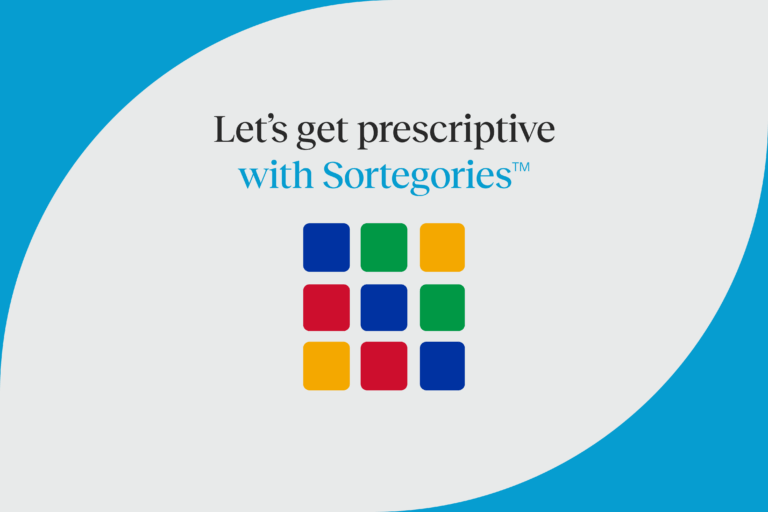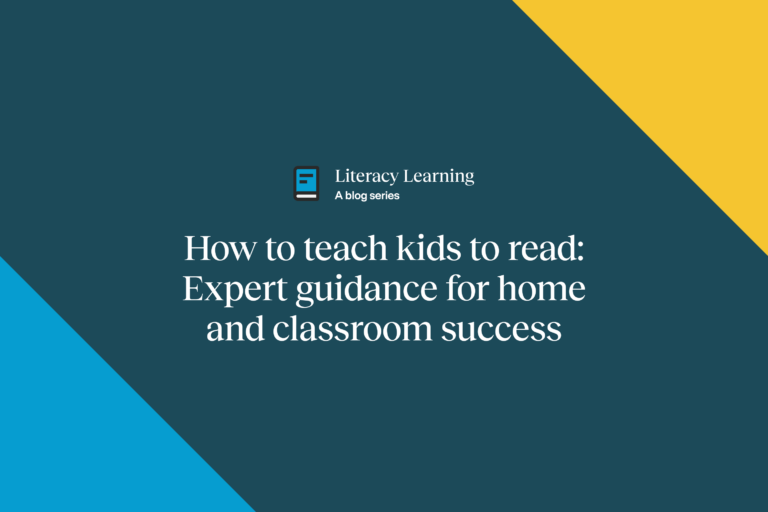The power of decodables in learning to read
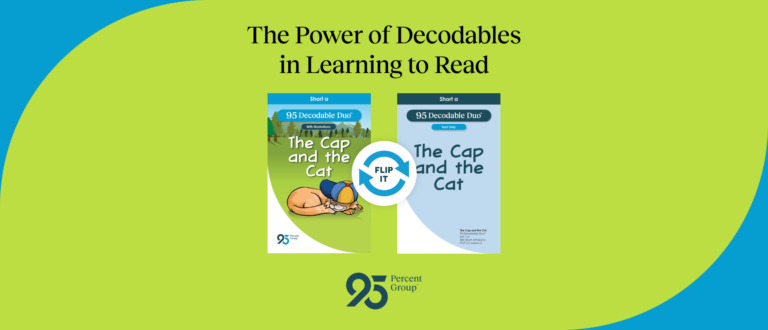
In a recent webinar, Laura Stewart, Chief Academic Officer at 95 Percent Group, and Joni Maville, director of content development, gave viewers a preview of 95 Decodable Duo™, an innovative new book series—developed to align with best practices in the science of reading and the scope and sequence of 95 Phonics Core Program®.
In this post, excerpted from the webinar of the same name, Laura Stewart shares what decodable text is, why it is so important, what features make up a high-quality, decodable text, and what some of the key studies and papers say about decodable text. Here’s Laura Stewart:
What is decodable text?
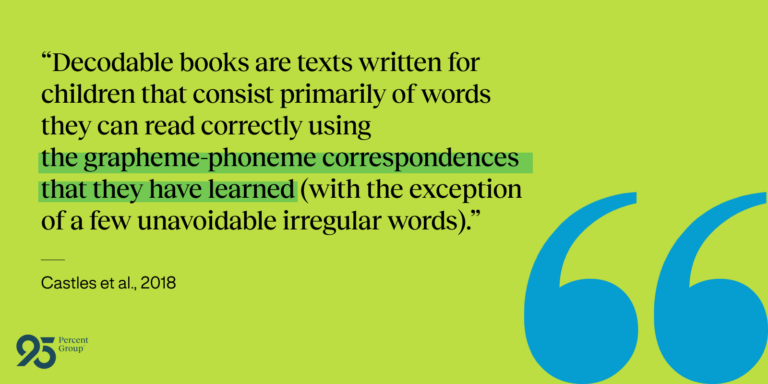
Let’s start with: What is decodable text? This is from one of my favorite papers, which I’m sure many of you are familiar with—Ending the Reading Wars: Reading Acquisition From Novice to Expert, written by Anne Castles, Kathleen Rastle, and Kate Nation.
The definition here is: “Decodable books are texts written for children that consist primarily of words they can read correctly using the grapheme-phoneme correspondences that they have learned (with the exception of a few unavoidable irregular words).”
And that’s a really important feature of decodable text: that it is made up of phonemes and graphemes that have previously been taught.
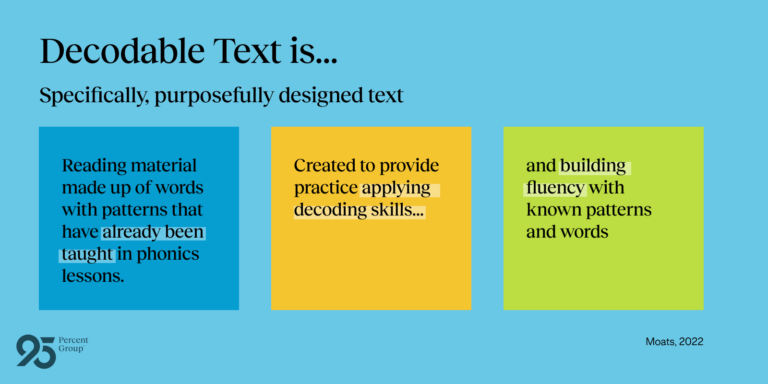
I’d like to emphasize the words specific and purposeful as well—specifically, purposefully designed text. Why? We want to make sure that decodable text aligns with what we have already taught. They’re designed so that students can practice applying decodable skills to build fluency with both known patterns and words that allow them to then generalize to unknown words with similar patterns. This background is from Dr. Louisa Moats—she wrote a really valuable booklet published by the World Bank Group in 2022—How Children Learn to Read: Toward Evidence Aligned Lesson Planning.
Why is decodable text so important?
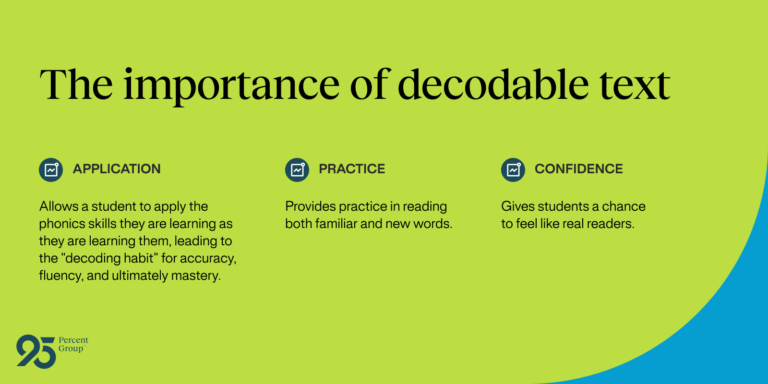
Application in literacy
First, decodable text allows our students to apply the fine skills that they’re learning as they’re learning them. It allows them to really develop the decoding habit that will lead to accuracy, fluency, and ultimately mastery. In terms of accuracy, we want students to be able to orthographically map words, and that requires them to practice in order to build those neural systems. And, according to Linnea Ehri in her 2014 paper, Orthographic Mapping in the Acquisition of Sight Word Reading, Spelling Memory, and Vocabulary Learning (Scientific Studies of Reading, 2014), decoding is the facilitator of that orthographic mapping.
In comparison with leveled text, decodable text promotes the habit of attending to the letters in the word as the primary means of recognizing the word—that is from a study that was done way back in 1985 by Juel and Roper-Schneider. They looked at students who were using leveled text versus students who were using decodable text and it was clear that the students using decodable text were really developing that habit of looking within the word.
Nathaniel Hansford, teacher, reading specialist, science of learning researcher, and author of Scientific Principles of Teaching, studies the role of decodable texts in learning to read. Providing guidance on the implications of the research on decodables for practice in the paper, “Do Kids Need Decodable Texts to Read?” (last edited 2024/02/10), Hansford makes the recommendation:
“Avoid predictable texts, as they may encourage bad habits like guessing at words.”
Practice
Practice could not be more important. We move from acquisition to accuracy to fluency, to comprehension, and the link from that accuracy to fluency is really that practice. We want to give kids practice in reading both familiar and new words with similar patterns.
Confidence
Finally, decodable text really gives our young novice readers confidence. I’m reading Hidden Potential, a wonderful book by Adam Grant, and he emphasizes that the research is really clear that the greatest factor in motivation is progress. Decodable text allows children to know that they are progressing as real readers.
Grant writes (on page 123): “Of all the factors that have been studied, the strongest known force in daily motivation is a sense of progress.”
So decodable text is incredibly important.
I want to contrast this with the type of text that I might have used in my early years as a teacher.
Here’s some text in a typical leveled reader, several weeks into kindergarten, perhaps…some kids would be given a book with this text to read during their reading instruction time.
I take pencils.
I take markers.
I take paper.
I take scissors…
Here are my questions: Is this student really reading? Is this student unlocking those words? Is she looking at the text and developing that decoding habit? Does my early kindergartner know that the sc spelling pattern in scissors says /s/? Does she know about the r-controlled pattern in scissors? Does she know about the long e pattern in take? No, she’s early kindergarten. She hasn’t been taught these things so what she’s being encouraged to do is to memorize the pattern, look at the picture, and from those two, guess at what that word might be at the end of the pattern. These strategies build visual word forms in the right hemisphere, an area not well-suited for building the neural networks required for reading.
The use of this text, then, encourages our students to use pictures and patterns, and doesn’t form that all important decoding habit that we know is critical in forming those neural pathways for securing the alphabetic code, enhancing orthographic mapping for automaticity of word retrieval.
And, in fact, frankly, what we know now is that using text like this encourages kids to adopt the habits of what poor readers tend to do as opposed to solid, fluent readers.
What does some of the research say about decodable text? There are several studies and analyses about the use of decodable text. I mentioned the Juel & Roper-Schneider comparison between first graders using leveled text and decodable text. Let’s take a look at some other studies, starting with one by Heidi Mesmer.
The Mesmer paper, Text Decodability and the First-grade Reader, basically, is all about how the teaching and the text cannot be separated. I like to sum it up like this:
- The kind of text we put in front of beginning readers determines the strategies that they will use.
- First graders who were learning phonics and using highly decodable text were more likely to employ their letter-sound knowledge than those using less decodable text.
- These students tended to read more words accurately and need less help getting through a text.
Another one is the Cheathem and Allor 2012 paper, The Influence of Decodability in Early Reading Text on Reading Achievement: A Review of the Evidence. Here’s an excerpt:
“Collectively the results indicate that decodability is a critical characteristic of early reading text as it increases the likelihood that students will use a decoding strategy and results in immediate benefits, particularly with regard to accuracy.”
So keywords here are: decoding strategy and accuracy, two things we want to develop with our young readers.
Now let’s look at Wiley Blevins. In An evaluation of the Decodable Text in Scholastic Phonics Readers, Blevins did some comparison with the first grade group, looking at students who were utilizing decodable text. His control group was using predictable and patterned text as well as popular books that were identified as only 35% decodable. And he found in his comparison that those students who used that decodable text outperformed the other students in terms of accuracy; they scored better on a phonics assessment. They scored better in spelling, and they self-reported their increased enjoyment of reading because they were successful. I believe they were motivated because they were making progress, and of course let’s also remember you can’t love what you can’t do. So giving kids these rewards in terms of being able to read really does impact their motivation and the joy that they get from being a reader.
In the Classroom Observation Results (page 8) in the report, Blevins writes:
“As further evidence of the power of controlled text, classroom observations also revealed that children in the controlled text group were more confident in tackling difficult books for their read at-home reading choices. It was observed that children in the experimental group would examine the words in books before selecting a story to take home. Conversely, children in the control group were observed to have difficulty choosing books with appropriate text for their reading level. The observers concluded that children in the controlled text group gained a greater confidence in their ability to decode the words in more challenging books.”
What makes a decodable text high quality?
So, to sum it up, here are some key features of what we call high quality, decodable text:
- A high proportion of words with phonetically regular relationships between the letters and sounds—so that kids initially have those reliable hooks as they read the text
- A close match between the phonetic elements in the text and what the reader has been taught
- Phonetic elements follow an evidence-aligned scope and sequence
- Cumulative decodability—in other words, what the students can decode in one book comes along into the next book with some new phonetic elements added. They’re always going from some of the known text into newly learned phonetic elements and securing what they’ve previously learned.
- Designed so that readers read the text without relying on the pictures—pictures play an important role in terms of meaning confirmation but they do not play an important role in terms of word recognition. So we want to make sure pictures are utilized properly.
- Text that has some natural sounding language
- Text that is engaging and appealing
In contrast, let’s consider an example of text that’s not engaging and appealing.
Now, this is just an example of something I found on the Internet. Decodable text does not have to be like this:
Mom has a big box.
Mom has a big bag.
Mom has a big wig.
Who cares? Right? So let’s contrast that with one of the books from our Decodable Duo series. This is part way into kindergarten. The students have been taught all their short vowels, so this book allows them to practice that. It’s called Fed in Bed. Here’s the text (watch the webinar to see all the accompanying images).
The sun is up.
Max, Lin, and Dad get up.
Mom is not up yet.
Max, Lin, and Dad have a job.
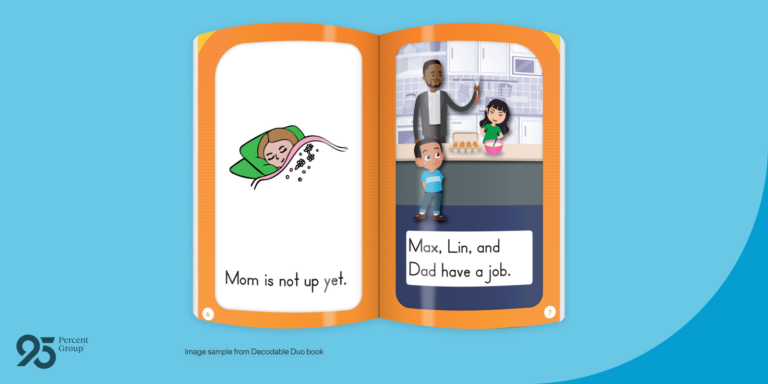
Lin has a cup.
Max has a bun and jam.
Dad has a hot pan.
They mix and they fix.
They did a good job.
Max, Lin, and Dad fed Mom in bed.
So that, of course, as you can see, is engaging. It’s a real story about a little family. Kids can get some enjoyment from reading that, because they will be successful. And it’s also very appealing.
Best practices in early text use
Sometimes one of the criticisms of decodable text is that it isn’t real literature. But remember, it isn’t meant to be. Of course we want to have rich literature in our classrooms, as well as books with no decodable controls for our read-alouds and our shared reading. We want to use those trade books and picture books and wonderful fiction and nonfiction, because our children’s listening comprehension, as you probably know, is much greater than the reading comprehension up through about the middle school years. So it’s through these experiences—read-alouds and shared readings—that children gain that knowledge of the world and the vocabulary, and it helps to lay that blueprint for comprehension as well.
At the same time, we want to be explicitly and systematically teaching our children the decoding skills and then allowing them to apply those decoding skills using that cumulative, decodable text to build those neural connections for automaticity and fluency.
Decodable text should be used for a short period of time, like “training wheels” according to Mesmer. It’s not forever. It’s during that time when we’re really trying to secure the understanding of how that code works, how they blend those sounds together in order to read words, and how words flow into sentences—that kind of fragile time as beginning readers. It’s a scaffold. And once students have secured those skills, then they can read without those same scaffolds.
Learn More
Explore our new 95 Decodable Duo™ Books here on our website. And to see a demo of Decodable Duo booksets and their unique patent-pending flip format with text-only on one side and illustrated text on the other, watch the webinar on demand.
Are you interested in learning about how you can bring an effective and efficient structured literacy approach, grounded in the science of reading, to your school or district? Contact us today.
Watch now
Our webinar, The Power of Decodables in Learning to Read: Solid Strategies for Teaching is available to watch now.
